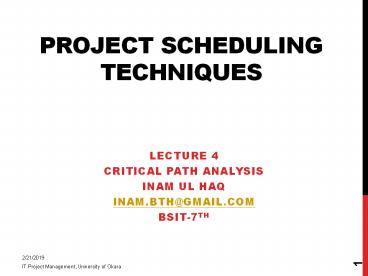Critical Path Analysis - PowerPoint PPT Presentation
Title:
Critical Path Analysis
Description:
Lecture 4 Subject: IT Project Management – PowerPoint PPT presentation
Number of Views:157
Title: Critical Path Analysis
1
Project Scheduling Techniques
- Lecture 4
- Critical Path analysis
- Inam ul haq
- Inam.bth_at_gmail.com
- Bsit-7th
2
Activity Resource Estimating
- Identify needed Resourced (Manpower, Equipment,
H/W, Etc) - Identify Quantity of Each Resource
- Verify Resource Availability to Perform The
Activity - Resource Breakdown Structure (RBS)
- Hierarchical Structure by Resource Category and
Type( Programmer, Analyst. Employee, Contractor) - Techniques Used for Estimation
- Expert Judgment
- Published Estimating Data
- Project Management Software ( For Resource
Breakdown Structure, Resource Availability and
Resource Rates Purposes) - E.g. MS Project Professional
3
Activities Duration Estimation
- The Duration Estimation Is a Progressive Task.
The More Accurate the Activity is Defined a
Better Estimate is Evaluated. - Techniques Used For Estimation
- Expert Judgment
- Analogous Estimation (Similar Activity,
Historical Information) - Parametric Estimation (Function Point, Etc)
- Three Point Estimation Most Likely, Optimistic,
Pessimistic ( Average of the 3 can be a good
baseline) - Reserve (Contingency, Risk, Etc)
- Duration Estimation Example
- 2 Weeks /- 2 days (8-12 Days)
- 15 probability of Exceeding 3 Weeks
4
Activities Sequencing
- Identify and Document the Logical Relationships
among Scheduled Activities. - The Activities Will Be Sequenced According to
- Precedence Relationships
- Leads To Support Later Development
- Project Schedules and Milestones
- Based on
- Project Scope Statement
- Activity List
- Milestone List
- Approved Change Requests
5
Precedence Diagram Method
- Activities Are Nodes (AON Activities On Node)
- 4 Types of Precedence Relationships (Arrows)
- Start To Finish
- Start To Start
- Finish To Start
- Finish To Finish
- Dependency Determination
- Mandatory (Hard Logic)
- Discretionary (Preferred Logic, Best Practice)
- External Dependency (Project Non Project
Relationship, Legal Constrains, Supplies Delivery
Deadlines, Etc) - Loops are NOT Allowed
- Dangles (Dead Ends) Are NOT Allowed
- Lagged Activities are shown on the arrows (
Documentation starts 2 days after Test Start
Dates) - Hammock Activity Has Zero Time. Represents
Resources such as Overheads with Constant Cost
Over the Duration of a Set of Activities
6
Activity Labeling For Sequencing Purposes
- Activity Label
- Activity Description
- Earliest Start
- Earliest Finish
- Latest Start
- Latest Finish
- Activity Span (Duration Between Earliest Start
and Latest Finish Maximum Time Allowed) - Float (Duration Between Earliest Start and Latest
Start) - Zero Span Indicates Critical Activity.
- Any Delay Will Impact the Finish Date Of the
Project)
7
Critcial Path Analysis
- A Network diagraming technique used to predict
duration - CPA determines earliest time of completion
- Longest Path, Multiple Paths containing all tasks
- Least Slack or Float (delay time)
- Critical path contains duration of each activity
- Precedence diagramming method to calculate
critical path
8
(No Transcript)
9
Now Calculte
- Free Slack (or Free Float) ?
- Total Slack (or Total Float) ?
- Early Start Date ?
- Early Finish Date ?
- Forward Pass ?
- Backword Pass ?
- Late Start Date ?
- Late Finish Date ?
10
Critical Path Method - CPM
- The Forward Pass Identify the Earliest Date an
Activity Can Start - The Backward Pass The Latest Date an Activity
Can Start Without Delaying The End Date Of The
Project. - The Critical Pass Calculate the Float Time. The
Critical Pass are the Activities with Zero Float
Time. - The Activities on the Critical Path should be
paid a special Attention as Any Delay in these
activities will Postpone The Project Completion
Date - Any wish to Shorten the Project Schedule Should
Deal With The Critical Path Activities
11
3
12
3
13
3
0
0
14
Schedule Compression
- Crashing Analyzing Schedule Compression with
MINIMAL Cost Increase - Fast Tracking Activities Which are Schedule to
Perform in Sequence (Discretionary) will Perform
in Parallel, This Will Add RISK to the Project
15
Apply Calendars
- Project Calendar ASSIGN ACTUAL DATES TO THE
PROJECT SCHEDULE - Adjust Holidays and others Vacation Days
- Resources Calendar
- Non Availability of Resources On Certain Dates
- Trainings Dates,
- Working Hours Information (Part Time Employee)
- Resource Leveling
- Shared or Critical resources May be Limited or
not Available in Certain Time. - The Project Management May Wish to Keep Some
Resources at a Reasonable Stable Level. - These Will Require Adjustments to the Project
Schedule - Generate Project Schedule Baseline for approval
and tracking of the actual performance
16
Schedule Control
- Reports the Current status of the project
schedule - Detects the factors that create schedule change
- Determine that the project schedule has changed
- Manages the actual change as it occurs
17
Schedule Control Tools and Techniques
- Progress Report Current Schedule Status
- Actual start and finish dates
- Remaining duration for unfinished schedule
activities - Schedule change control system
- Paperwork, tracking system and approval levels
for the schedule change procedure - Performance Measurements
- Schedule Performance Index (SPI), Schedule
Variance (SV) - Project Management Software
- Variance Analysis Compare Target schedule dates
with actual/forecast ones. Used for deviation
detection and correction activities (Example A
major delay in non critical path activity may
have a small impact) - Schedule comparison bar chart
18
Schedule Control Outputs
- Schedule Model Updates
- Modifications to the project schedule model
- Notification of appropriate changes to the
stakeholders - New project schedule network diagram is developed
- Schedule Baseline Update ( As a result of
approved change requests) - Performance measurements
- Requested changes
- Recommended corrective actions
- Lessons learned documentation updates
- Updates of relevant projects sub planes
19
Exercise
- What to do if a task on critical path is behind
schedule? - Critical path can be changed after started?
- Apply Critical Path Analysis on your topic.































